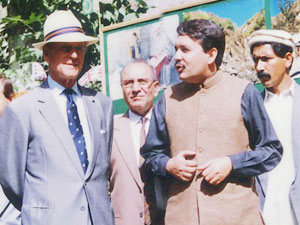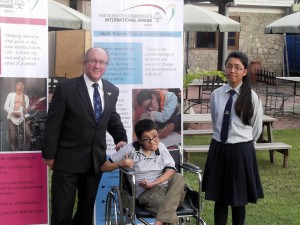A year ago in this blog I explained how my visits to Nepal over the years and the friendships I made there led me to take up a voluntary position as trustee of a charity providing educational support for Nepalese schoolkids. It’s one year on and I thought it’s time I provided an update, as there is an interesting Everest connection to report as well as an amazing story of stoic determination that would impress even the hardiest Sherpa.
CHANCE was established as a UK charity in 2004 by the daughter of a trekker I met in the Annapurna region a couple of years earlier. I helped out as a volunteer providing their website from the early stages, and became a trustee after climbing Everest in 2012. This time last year I explained how the charity was trying to establish the Duke of Edinburgh’s International Award into schools across Nepal.

For those of you born and brought up in the UK the Duke of Edinburgh’s Award (known more simply as the D of E) may evoke memories of slogging your way across a misty hillside with a map and compass, carrying a 10kg pack on your back, and struggling to erect a tent in the pissing rain with a handful of your similarly inept school friends. The award was established in the 1950s as a means of providing young people with a more rounded education outside the school curriculum. It involves learning non-academic skills, helping out as a volunteer and doing a sport or other physical activity, but the bit everybody remembers it for is the “expedition” part, which invariably involved a hike in the hills when the weather was shit. Or so I’m told. I didn’t actually complete the DofE myself because on the day I turned up to start my bronze award I discovered I was the only boy in a group of around 20 enthusiastic girl participants (and for a 14 year old school boy, there can be few things more mortifying).
Until now the Duke of Edinburgh’s Award has not generally been associated with Nepal, but CHANCE hopes to change that. When Prince Philip the Duke of Edinburgh visited the country himself in 1961 he found himself in the delicate position of being invited to participate in a tiger shoot. Unusually for His Royal Highness, who is famous for his diplomatic blunders, he managed to avoid offending his hosts by emerging on the day of the shoot with a giant bandage on his trigger finger which meant he would be unable to compete.
But there is a much deeper connection with Nepal than that. What not many people know is that the very first director of the DofE award in 1956, and the man who helped devise it, was Colonel Sir John Hunt, who led the first successful expedition to climb Everest which put Edmund Hillary and Tenzing Norgay on the summit on 29 May 1953. As the award became more popular it expanded internationally through the support of schools and youth organisations across the British Commonwealth. By 1971 it was operating in 31 countries, and this had expanded to 48 by 1988, when the Duke of Edinburgh’s International Association was established. By last year it was operational in 140 different countries, but in Nepal, which thanks to Sir John Hunt’s contribution can be thought of as its spiritual home, it was only available to a privileged few, such as students in a handful of private schools like the British School, Kathmandu and Kathmandu University High School.

CHANCE took it upon our shoulders to promote the award more widely with the aim of making it available to all children in Nepal irrespective of background, wealth or location. We are now the National Award Operator, responsible for providing award leader training and helping youth organisations to obtain their operating license. We have carried out training sessions as far afield as Jhapa in the far eastern Kangchenjunga region, Chitwan in the south and Pokhara in the mid-western part of the country. There is still much to do and our ultimate aim is establish a local Nepali organisation as National Award Authority, help it to become self-supporting, and eventually hand over responsibility. We received the best possible Christmas present when the Duke of Edinburgh’s International Award Foundation itself gave us a £25,000 GBP grant to support our programme in Nepal over the next three years.
With funding secured our marketing focus has switched from international donors to local Nepalis working in the youth sector and ultimately to young people themselves. In order to achieve success we need to convince students and teachers that participating in the DofE award will lead to a more rounded education and a better quality of life. We have hired our first two full time employees, Rupak and Pritisha, to work on regional development in the field and provide programme support in Kathmandu. One of the most interesting parts for me has been learning about the lives of our four new DofE patrons, all of whom are high profile Nepali public figures who we hope can inspire young people to take up the challenge. They include two-time Everest summiteer Dawa Steven Sherpa, who is a graduate from Edinburgh’s Heriot-Watt University and a WWF ambassador, Nepali rock musician Robin Tamang, and international shooter Sneh Rana, who participated in the London 2012 Olympics and will actually be trying to achieve her bronze, silver and gold DofE awards as part of her role.
But the most inspirational person by far is our skills patron Jhamak Ghimire, who has had a life so astonishing that were she a man born in the developed world then Daniel Day-Lewis would be playing her in a movie. She was born in the village of Dhankuta in the Himalayan foothills in eastern Nepal with a form of cerebral palsy so severe she is unable to use her arms or speak, and her legs are so weak she cannot walk. Her misfortune was compounded by being raised in a culture which viewed disability very differently to the one that provided a degree of support to the Irish writer Christy Brown, subject of the film My Left Foot which won Day-Lewis an Oscar, and whose life Jhamak’s parallels.

But Jhamak was blessed with a strength of character and quiet determination so powerful she makes a team of Sherpas shouldering 50kg loads through the Khumbu Icefall look like a bunch of western commercial climbers. Her community believed her disabilities were a result of terrible things she had done in previous lives. This meant that far from receiving the sympathy she badly needed she was shunned and despised. It was believed her existence was a curse on her family, and her presence brought bad luck to all those who crossed her path. Her literate father regularly beat her for sneaking a look at her sister Mina’s school exercise books, and there was no possibility of her receiving any formal education. Undeterred she listened to Mina’s lessons surreptitiously, and learned to write in the dust with the toes of her feet. Mina was her only ally, who stole pens for her and gave her some sneaky sheets of paper to write on. By the time Jhamak was in her teens, word began to spread that there was a remarkable child who was able to write using the toes of her left foot, and people came to her village from long distances to watch. By then it was realised she was a blessing rather than a curse, who could earn money for her family by writing for the crowds who turned up at the house. But Jhamak didn’t want to be a circus performer, and she refused.
Jhamak’s experiences as a child has given her an inner strength and a rebellious streak which means she is not afraid to challenge authority and existing customs. Unusually for a Nepali she is not religious, and has refused the patronage of powerful people in Nepal at various moments in her life, including the former royal family. She writes regularly about politics in the Nepali language daily Kantipur, and has been critical of both the Maoist rebels and the royal family. She is now one of Nepal’s most respected writers and has won numerous awards for her essays and poetry. Her autobiography A flower in the midst of thorns has recently been published in English, and although the translation is a little idiosyncratic at times, I found myself reading it with my jaw mostly in a dropped position. I had it on me when I met my father in a pub beside the Thames in London a couple of weeks ago. When I told him who Jhamak Ghimire was he asked whether she was one of the people our charity is supporting. But she doesn’t need our help and I explained to him that it was the other way round: she was supporting us. We hope her patronage will inspire not only young people in Nepal but all our donors worldwide who have led comparatively comfortable lives.
I will be returning to Nepal for the tenth time next month, and I will never cease learning amazing things about the country. As I struggle through the Khumbu Icefall myself during my attempt to climb Lhotse, I will think of Jhamak and consider that what I am doing is not so very extreme.
You can find out more about what we are doing for the DofE award in Nepal on the CHANCE website.







Hi Mark.
.I was in Nepal last year and having a beer in the front garden area of Kathmandu Guest House. As you will know, the security gates opened at the entrance and in drove a brand new Toyota Land Cruiser. Now, I’m no expert, but I was looking at about 40k worth of vehicle. Plastered all over the vehicle was the logo of PLAN UK. Out got the occupants and booked in the hotel.
At that time we sponsored a child from Bangladesh named Snikda, my wife and I had supported her for over 5 years. We sponsored her through PLAN UK. Upon returning home we wrote to PLAN to ask various questions about their spending but never received an answer we were happy with. Thanks to your inspirational article, we have now found another way to help. Take care on Lhotse and I’ll have a cold beer to toast your success in Tom @ Jerry bar when I land there in October…..
Regards as always
Martin Berry
Thanks, Martin, especially if you are considering supporting CHANCE. I can’t speak for how other charities spend their money, but one of my responsibilities as a trustee of CHANCE is to monitor how our donations are spent. 40K would do very nicely and as well as supplementing our DofE programme, it would enable us to expand and continue the teacher training programme we ran last year. Landcruisers are not under consideration at the moment. 🙂